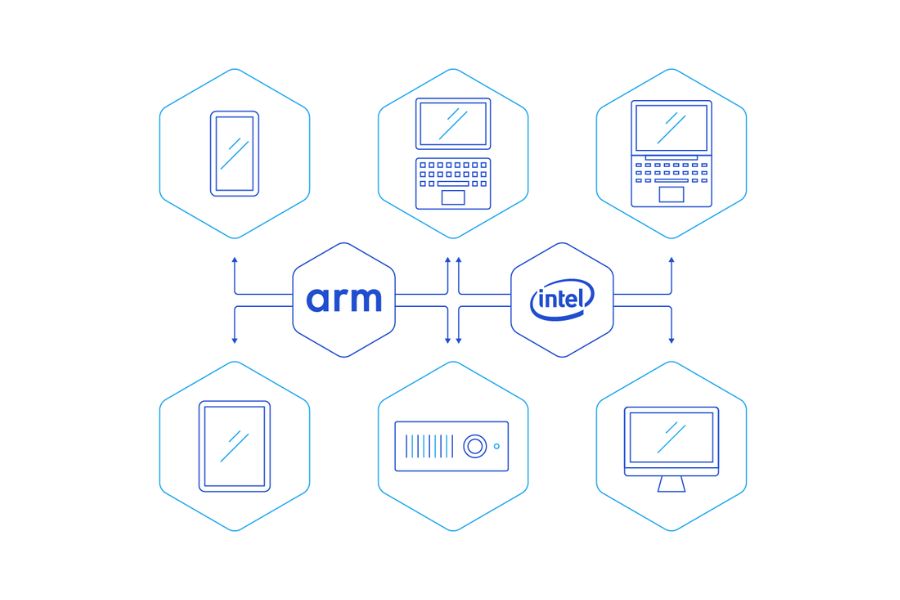ARM and x86 are two major architectures in the world of computer processors, with long-standing competition in the market. One notable incident that highlighted the battle between them was when Apple made a huge decision to transition from using x86 architecture to adopting ARM for their Mac computers. So, what exactly are they, and what sets them apart? In this article, let's take a closer look at these architectures and learn about what makes them unique, their benefits, and the compromises they come with. x86 on the other hand is the instruction set architecture developed by Intel Corporation and AMD. The x86-based processors are built on the Complex Instruction Set Computing (CISC) design. The architecture is well-known for being able to run older software without any issues, and it is also very good at handling tasks that need a lot of computing power.ARM and x86 architectures differ in terms of their instruction set design, power efficiency, and scalability/customization options.
x86 on the other hand is the instruction set architecture developed by Intel Corporation and AMD. The x86-based processors are built on the Complex Instruction Set Computing (CISC) design. The architecture is well-known for being able to run older software without any issues, and it is also very good at handling tasks that need a lot of computing power.ARM and x86 architectures differ in terms of their instruction set design, power efficiency, and scalability/customization options.
What are ARM and X86?
ARM (Advanced RISC Machines) is an instruction set architecture developed by ARM Holdings. The ARM-based processors are built upon the Reduced Instruction Set Computing (RISC) design. They are known for their power efficiency, making them popular in computer systems with low power requirements.
Architecture
As mentioned above, ARM follows the RISC architecture, which focuses on simplicity and efficiency. Here, the architecture has simpler instruction sets, that can execute as fast as possible (one instruction in one cycle). This results in quicker execution of tasks.CISC architecture often features more complex instructions, which can reduce the number of instructions needed to perform certain tasks. Although these complex instructions may take multiple clock cycles to execute, the overall task completion rate can be faster due to the reduced instruction count.Power Consumption
ARM processors are good in terms of power efficiency. They try to complete commands using the simplest instructions, saving a substantial amount of power. This makes ARM chips suitable for battery-powered devices and mobile applications.x86 CPUs generally use more power when solving problems and performing tasks because they require additional energy to execute complex instructions. However, recent advancements have improved the power efficiency of x86 processors, especially in the low-power and ultra-low-power segments.You might want to read these:Efficiency
ARM utilizes a design called big.LITTLE architecture. This means it has two sets of cores: powerful cores (big) and efficient cores (little). Demanding tasks use powerful cores, while efficient cores handle less intensive tasks. Historically, x86 architecture did not have this specific big.LITTLE design, but Intel introduced Performance and Efficient cores with 12th Gen "Raptor Lake" onwards.Scalability and Customization
ARM Holding does not manufacture the silicon chips, it only gives a design architecture of how the chips can be manufactured. Manufacturers can customize ARM-based processors to meet the specific requirements of different devices and markets. As a result, ARM architecture is popular for its high scalability and extensive customization options.Intel and AMD themselves design, combine, and manufacture the silicon chip based on x86 architecture. It too also offers scalability, but to a lesser extent compared to ARM. The scalability and customization are typically limited to modifications made by the processor manufacturers themselves i.e. Intel or AMD.Apple switched from using x86 to adopting ARM architecture for its Mac
Apple is famous for its unique technologies in mobile and Mac computers. Initially, the company relied on x86 chips for its Macbooks, but it eventually changed to ARM. Apple switched to ARM because it offered benefits in scalability and customization.From the beginning, the Mac has always embraced big changes to stay at the forefront of personal computing. Today we’re announcing our transition to Apple silicon, making this a historic day for the Mac. - Apple Worldwide Developers Conference (WWDC) held on June 22, 2020.Apple holds an architectural license from ARM, enabling them to design and produce their own chips. This grants Apple greater control over the hardware support they incorporate into the chips. Consequently, Apple can create highly optimized computing devices customized to meet their customers' needs. Also, RISC-based microprocessors are small in size, which helps Apple achieve its slim design.
Compromises that come with both the Architecture
ARM processors have a strong existence in the mobile market and are compatible with various operating systems, including Android and iOS. However, they may not offer full compatibility with some older desktop applications and software. Also, they are energy efficient, that's why, they may not provide the same level of performance as high-end x86 processors in certain demanding tasks.x86 processors dominate the desktop and server markets. They are compatible with a wide range of operating systems, including Windows, macOS, and Linux. Since it can operate complex tasks, it is expensive, less scalable, and highly demanding in power.- Meanwhile, check out our comparison of the latest smartphone chipsets.

To say something about myself, I have been writing tech and gadgets from 2021. Although coming from a non technical studies background, I'm someone who is always fascinated by the latest gadget and tech innovations, circling around. Besides writing, you'll find me listening music and aligning the stars through astrology and sometimes even, tarot cards! 😉🧿
Comments
No comments yet. Add a comment to start a discussion





